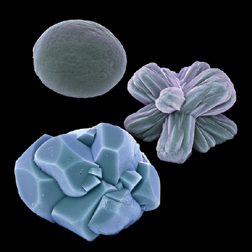Underwater balancing act
- More than 2 years ago
Tweaking the structure of crystals nestled in the inner ears of zebrafish can throw the fish off balance, biologists have found. During development, proteins guide the assembly of calcium carbonate molecules into tiny crystals called otoliths. These structures, which lie on top of gravity-sensing organs in the inner ear, influence both balance and hearing.

Researchers from the Max Planck Institute for Developmental Biology in Tübingen, Germany, and the European Synchrotron Radiation Facility in Grenoble, France, identified a gene that codes for one of the crystal-organizing proteins.
When the researchers hindered the activity of the gene, the fish developed elaborate star-shaped otoliths, instead of the spherical structures found in normal fish. Silencing the gene, dubbed Starmaker, resulted in a different crystal altogether. In normal otoliths, calcium carbonate forms crystals known as aragonite–the same form of calcium carbonate that forms pearls. In the Starmaker-silenced fish, however, the minerals form large, chunky calcite crystals.
In tanks with moving water, fish with the modified otoliths became disoriented and swam in circles. The research team, led by Teresa Nicolson, who is now at the Oregon Health and Science University in Portland, reports its findings in the Oct. 10 Science.
In people, a similar protein has been associated with hearing loss and teeth formation. The zebrafish work may lead to a better understanding of deafness and dental defects, the researchers say.
****************
If you have a comment on this article that you would like considered for publication in Science News, send it to editors@sciencenews.org. Please include your name and location.